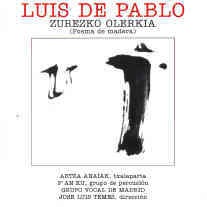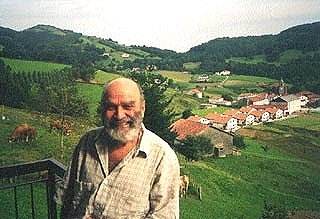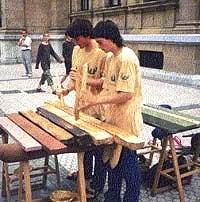

Luis de Pablo Zurezko Olerkia
Artza Aniak, txalaparta
P'An Ku (percussion group)
Vocal Group of Madrid/Jose Luis Temes
Iberautor SA00863 [60 mins]
emanzanares@sgae.es
It is good news that this unique work is now available on CD. It is, in many ways, of its time; the late '70s. It should appeal both to World Music devotees and to people who have enjoyed such music as Stockhausen's 1968 STIMMUNG (TUNING) for 6 vocalists and sound projection.
The notes are very comprehensive; Luis de Pablo characterises his Poem of Wood as "a long meditation with no sense of direction"; the conductor describes it as one of de Pablo's masterpieces, "a calm, reflective journey through the Basque landscape".
This 1992 studio recording made in Madrid is a great success. It features the same txalaparta players - whose parts are not notated conventionally - that we heard in San Sebastian, summer 2000. They were twin brothers (not the players in my illustration), one of whom has died shortly before the CD was released.
I can do no better than to reproduce the relevant extract from our report of the San Sebastian Festival in Seen&Heard: - - With concert promoters having an insatiable appetite for the new, it was good that the first Pablo concert at San Sebastian was given over to a unique work in his  oeuvre, and one with strong local connections to his proud Basque origins (though based in Madrid, he spends the summers composing in a Basque retreat in northern Spain).
oeuvre, and one with strong local connections to his proud Basque origins (though based in Madrid, he spends the summers composing in a Basque retreat in northern Spain).
Luis de Pablo at his Summer composing retreat |
|
Zuresko Olerkia (1975) was given by Grupo Vocal KEA with percussion & txalaparta. It is an extraordinary hour-long creation; quiet and static, but with endlessly fascinating patterns to engage the listener. Pablo often avoids using percussion for mere power and volume, and here four players accompany the choir's sustained chords with alternating, fully notated passages on mainly tuned percussion instruments, rarely rising even to mf .  They fall silent for long passages which are given over to the local Basque instrument, the txalaparta , three examples of which were placed behind the choir, to the side of the audience and at the back of the hall respectively. These are played by two unschooled, duetting musicians, who improvise together within prescribed parameters.
They fall silent for long passages which are given over to the local Basque instrument, the txalaparta , three examples of which were placed behind the choir, to the side of the audience and at the back of the hall respectively. These are played by two unschooled, duetting musicians, who improvise together within prescribed parameters.
txalaparta players in San Sebastian
The success of Zurezko Olerkia depends largely on a perfect symbiotic relationship with the concert and folk percussion instruments, which surround and frame and almost literally hold the voices in place. When the regular patterns break up the voices become forceful and almost windblown but still contained through the most virtuosic playing at this point on the traditional Basque txalaparta. The complex, embroidered and pearly woodblock rhythms, played from the sides and then from the back of the hall, weave themselves into the vocal sounds. At first they hold the voices in place, then set them free to float on their own before the professional percussionists behind the singers join in to give body to floating sounds which finally just stop, suspended in mid-air.
A most thrilling and memorable event. (Peter & Alexa Woolf)